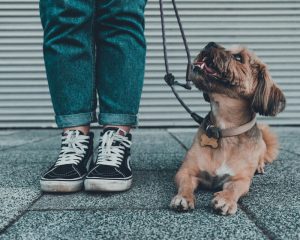Keeping your dog mentally and physically stimulated does wonders for their overall health and happiness. Whilst as an owner you may look at the amount of rest and relaxation your dog can get throughout the day with a little bit of envy, dogs don’t want R+R all of the time and may become bored or restless just like us. So, what can you do to ensure they stay as stimulated as possible? After all, life enrichment isn’t just a human need.
From interactive play to fun training sessions and even regular days out can all provide regular and varied stimulation for your four-legged friend, so below, we’ll explore a range of activities designed to keep your dog active and engaged all day long. That way you can have a happy, healthy, and well-adjusted pooch.
Why Your Dog Needs Stimulation
Stimulation has a key part to play in how your dog develops throughout its life, both physically and mentally. Without adequate physical exercise, dogs can develop a range of health issues, including obesity or joint problems such as arthritis. Regular activities such as going for walks runs on the beach, or even a game of fetch can all help maintain their physical well-being. It will also give them plenty of opportunities to explore and interact with the environment around them. Much like us humans, dogs aren’t designed to have a sedentary lifestyle.
Mental stimulation is just as important. Dogs are intelligent creatures with active minds, and so they crave engagement. When they’re not provided with enough mental stimulation, dogs can develop behavioural issues such as anxiety or excessive barking, showing their frustration. That’s where engaging activities like learning new tricks, solving puzzles, or playing interactive games can provide cognitive enrichment, offering a mental workout that will prevent boredom and stimulate their natural curiosity.
Without this stimulation, you’ll find it much harder to build a bond with your furry friend. Upping physical and mental exercise for your dog where needed will help strengthen your connection and increase trust between you both.
Physical Activities That Will Engage Your Dog
If you want to have a healthy, happy, and well-behaved dog, you’ll need to give them plenty of exercise. Depending on your dog’s breed, age, and physical condition, the type and intensity of exercise will need to be adjusted. For most dogs, daily walks are essential, not just for physical exercise but also for sensory stimulation. Keeping this varied by organising regular days out that give your dog something new in different environments will help. You may also want to try some other activities where you can:
- Fetch – A classic game of fetch using tennis balls, frisbees, or other toys always goes down well. It’s a great activity for your dog to practise their natural retrieving instincts.
- Agility Training – Setting up a simple agility course in your garden with tunnels and obstacles can significantly boost your dog’s agility, confidence, and mental awareness. You may also want to seek out a local agility training club which provides the perfect environment for this.
- Swimming – For breeds that enjoy being in the water, swimming is an excellent form of exercise that is easy on the joints and perfect for cooling down on hot days. Just ensure they stay safe whilst doing so.
- Tug of War – Just like fetch, having a controlled game of tug of war is a simple way to increase physical activity. It can also help build your dog’s strength and is a wonderful way to interact directly with them.
Be sure to regularly change things up and rotate these activities as well as others you may want to try as this will not only keep your dog physically fit but also ensure they remain eager and excited about their daily outings.
Not every breed is the same, so the games and physical activities you have in mind need to be a good match. Some dogs have much higher energy levels than others, for example, a Chihuahua has moderate energy levels (as well as being much smaller) when compared to a Cocker Spaniel or Labrador with higher energy levels according to vet charity the PDSA, so take some time to fully understand your dog’s needs.
It’s important to not overdo it too, especially if your dog is older. They may want to act like a puppy and keep playing for hours, but their joints may not agree, so keep everything in moderation and look for low-impact activities like walking or swimming that can avoid too much strain.
Mental Stimulation Games & Toys
Integrating thought-provoking games and toys into your dog’s daily routine can greatly enhance their cognitive skills and alleviate signs of boredom. Using food and toys in a creative way can be ideal here according to Battersea Dogs and Cats Home, as dogs are highly motivated by food, although you’ll want to ensure you’re not overfeeding them or using too many unhealthy treats to do so. Here are some effective ways to keep your dog mentally sharp:
- Puzzle Toys – These toys encourage your dog to solve problems to receive a reward with a bit of persistence. Toys that have sliding doors or movable pieces that hide compartments for food are ideal.
- Hide and Seek – Engage your dog’s natural hunting instincts by hiding treats or their favourite toys around the house or garden for them to find. This not only trains their sense of smell but also adds a bit of variety to their playtime with you.
- Obedience Training – Regular, short training sessions that reinforce basic commands or teach new tricks are excellent for mental stimulation. They keep your dog’s mind engaged and strengthen your bond.
- Interactive Games – Toys that respond to your dog’s actions can stimulate their curiosity and provide fun challenges. Along with puzzles, you can try snuffle mats where you can hide food for them to find or even create a destruction box from cardboard that contains some of their favourite toys to search for.
Keeping your dog’s mind active and engaged is the simplest way to stop them from becoming bored and having to resort to destructive or attention-seeking behaviours such as excessive barking or chewing things they shouldn’t. It may take a bit of preparation and thought, but you’ll hopefully find stimulating games and toys your dog will love to play with over and over again, changing up the variety every once in a while to keep things fresh for them.
Social Interactions Are Also Important
Your dog’s emotional health and social development go hand in hand with regular exercise and mental stimulation. Regular interaction with other dogs and humans helps to build confidence, teach proper social behaviours, and reduce anxiety. Here are some of the ways you can ensure your dog gets adequate social time:
- Dog Park – Visits to local dog parks provide a great opportunity for your dog to interact with others in a safe, controlled environment. This helps them learn how to approach and play with other dogs respectfully. Just be sure to keep an eye on them.
- Playdates – Arranging playdates with familiar dogs of friends and family can offer more personalised interaction. This is a simple way for them to have social interaction regularly which can be less overwhelming when compared to a dog park.
- Training Classes – Joining a group training class not only helps your dog learn to be obedient but also allows them to meet and interact with others and make new friends.
It’s important to slowly introduce social interaction for your dog and find the right balance. If they haven’t had proper training so far or are reactive around other dogs, this can be a stressful or triggering interaction according to pet insurance provider Petgevity, so speak to your vet or with a trained behaviourist first to get an expert opinion. You can find a registered behaviourist or trainer by visiting the Animal Behaviour and Training Council (ABTC) website.
Keep a Routine & Stay Consistent
Once you have your preferred mix of physical and mental activities planned, it’s all about staying consistent. Once your dog gets into a new routine, they will quickly notice if you forget a key part of it, especially if they enjoy it. A predictable schedule for meals, walks, playtime, and rest is best. It will provide your dog with a sense of security and structure to their days, which can greatly enhance their overall well-being. If all goes well, your dog will stay as active as possible throughout their lifetime and feel both content and comfortable.






